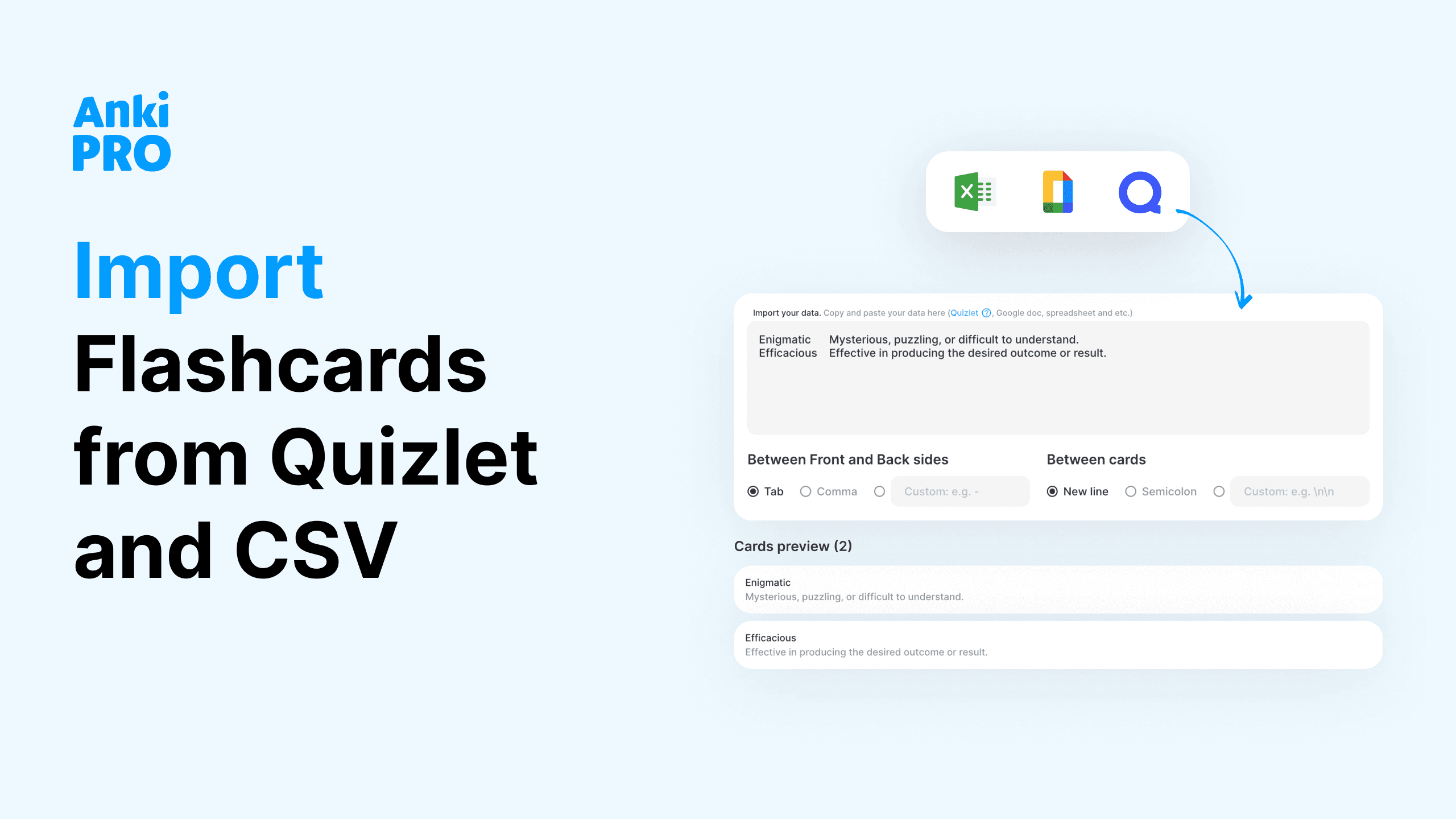Do you want to memorize flashcards quickly and store the information in long-term memory? In this article, we’ll explore effective learning strategies, including twelve classic and trending techniques to enhance your study sessions. Discover the best ways to memorize flashcards based on your subjects, goals, and deadlines. You might even find a personal ultimate flashcard hack that changes everything!
💡 Create memorizable flashcards
Even though you can find almost any deck of flashcards you can think of, it’s great to make your own flashcards.
Remember the ultimate flashcard tip: keep them simple. Avoid overloading flashcards with vague information. Break down complex information into simple, digestible parts. Each flashcard should focus on one key concept or fact to avoid overwhelming your brain.
Poorly designed flashcards are vague flashcards. It’s the most common mistake of those students who find it hard to integrate flashcards into their study routine. Most flashcard apps allow creating good flashcards with options to add multimedia elements and preferred formatting. Master flashcard creation for memorizing information, saving time, and enjoying the whole process of learning!

💡 Color code study material
Flashcards incorporating color help to activate distinctions between topics and subtopics.
Yes, it takes more work to use color — that is the point! Ultimately, this little bit more work your brain takes in being creative through color forms stronger memories and neural pathways.
Color helps especially when using “word only flashcards” to add another layer of visual distinction. When there are multiple answers for the same flashcard, color creates meaningful separation. Get creative!
💡 Review regularly
The Ebbinghaus forgetting curve demonstrates how your brain forgets key information over time when you do not review.
The timing and method of your study sessions are crucial for creating long-term memories.
While reviewing information is vital, doing so at the right intervals is even more important. It might be stressful to schedule review sessions, so it’s very wise to use a spaced repetition flashcard app (try Anki Pro for free!)

💡 Use the advanced buddy system
Studying with a partner allows you to explain concepts to each other, reinforcing your understanding and highlighting knowledge gaps. Teaching and learning together solidifies the material for both of you. For basic recall practice, ask a family member or friend to quiz you; we promise it’s better than studying alone.
In an online environment, use platforms like Flow Club. Studies show that ‘body doubling,’ or working with a partner, significantly increases focus, especially for those managing ADHD, enhancing effective studying. Plus, it’s much less lonely.
💡 Go for digital flashcards
Use a digital system for creating flashcards and organizing them into decks and sub-decks.
You can use physical flashcards (read about their pros and cons here), however, digital flashcards offer many benefits, especially for college students who need to juggle lots of information. Most digital flashcard apps allow you to quickly locate relevant flashcards, and seamlessly create flashcards in one place.
Modern-day flashcard apps, including the awesome spaced repetition app Anki Pro, are built on smart algorithms, such as SRS (Spaced Repetition Systems) and FSRS (Free Spaced Repetition Scheduler). And those are not just fancy terms to throw in. Spaced repetition algorithms are designed to present flashcards at increasing intervals based on how well you know each card. It makes memorizing flashcards scientifically effective, stimulates active recall and fights the Forgetting curve mentioned earlier.

💡 Practice mind mapping
Challenge yourself to create a mind map under short time constraints, like ten to fifteen minutes. Mind mapping is a great tool to gather existing knowledge and writing out all the topics you may need to learn. Using this tool with time constraints will show you what you need to learn; it will also help visualize existing knowledge and help to avoid memorizing useless information. For example, if you need to memorize all the world countries, it’s smart to group them into mainlands.
Start by writing the main topic in the center of a paper, and then create branches out from the center with subtopics and any background information related. Don’t worry if this looks neat and tidy, it’s for your eyes only!
The mind mapping approach is great for understanding study materials as well as personal knowledge management.

💡 Try multisensory memory activation
When reviewing, try to trigger all parts of your memory. The easiest way to activate all parts of your brain while studying is to think of touch, sound, sight, emotions, and more. You might even use your memories of spatial areas, taste, and smells.
Use strong memories to aid in strong neural connections. To get an idea of how to do this, read and observe how writers explore multicultural perspectives to engage their senses. This can be great inspiration!
💡 Embrace gamification
Turning flashcard studying into a game can make it more engaging.
Instead of using word only definitions on one side of your flash card, you might create a puzzle that forces you to recall information.
Example:Let’s say you have a list of books and you need to remember what each book is about. On one side you have the author, on the other side the title of the book.
If the other is Laura Ingles Wilder, on the other side of the flashcard, you might draw some green grass, a red barn house, and a small dog that represents the author’s dog, Jack, instead of writing “Little house on the prairie”
💡 Create quirky drawings
Continue to activate your inner artist! Let’s say we want to create a drawing on one side of a flashcard for language learning; if you’re into language learning, and the word you want to learn is “cow” in Spanish, don’t just draw a plain cow or use a piece of clip art. Think about a time you saw a cow in real life that really stuck out to you. Maybe this cow had brown spots, a pink, wet nose with little freckles, and a tuft of hair at the top.
This is the kind of meaningful drawing that will activate your memory. These drawings don’t have to be “perfect” they just have to symbolize what is personal to you.
💡 Integrate mnemonic techniques
In 1967 Gerald R. Miller conducted a study that found students who used these devices increased test scores by a whopping 77%. Mnemonics are language devices that cleverly help you remember word order and associations.
There are so many mnemonic techniques you can use in your own words to help your memory. Here’s a name Mnemonic for the types of Mnemonic techniques: Music, Name, Expression, Model, Ode, Note, Image, and Connection.
Use your own words to make mnemonics relevant and rememberable for you.
💡 Create a digital memory palace
The memory palace technique essentially takes all the mnemonic devices in order to create an organized “palace” for your memories. You can use a digital memory palace for items that have a specific order.
Use a place that is familiar, like your house, bedroom, or classroom. To make it even easier, use a place where you study often. You’ll want to imagine you’re walking through this space and place the triggers for the flashcards you’re studying throughout the room.
For this example, let’s use the periodic table of elements and say you need to memorize flashcards of the first three elements in their specific order.

Create a “mental journey” in this memory palace to create a storyline that will serve as a memory trigger for each element.
The following list is an example of how you might use this memory palace to memorize the first three elements: Hydrogen, Helium, and Lithium.
1) You let out a sigh when you come home.
The ‘H’ sound stands for Hydrogen.
2) You stub your toe at the corner of the bed. “What the heck!”
The first ‘he’ in heck stands for Helium.
3) You place down your book bag at the edge of the bed. Wow, much lighter.
First two letters of ‘lighter’ stand for Lithium.
It doesn’t matter if the place is real or if the events actually happened! It does help if you can involve strong feelings and your own words when you create memory palaces.
💡 Make a study podcast
Record yourself reading your flashcards to reinforce rote learning. Listening to these recordings repeatedly can help with retention, plus you can listen while doing other activities like brushing your teeth, making lunch, or walking your dog.
Record yourself reading the flashcards, speaking clearly and at a moderate pace. Add explanations or examples to elaborate on key points. This makes your study sessions comprehensive and effective. If you want to listen to your flashcards more quickly, you can even play back the recording at 2x speed. Whatever works for you!
You don’t have to share this podcast with anyone, unless you want to. Creating an organized folder on a laptop or phone can create an audio-repository for notes you can listen to while on the go.
💡 Prioritize mindfulness and relaxation
Studies have shown that mindfulness meditation can significantly improve working memory capacity and cognitive performance.
Research by Zeidan et al. (2010) demonstrated that just four days of mindfulness meditation training led to notable improvements in working memory, executive functioning, and sustained attention: all crucial components for effective studying and long-term memory retention.
Before starting your study session, practice a few minutes of mindfulness or deep breathing to clear your mind and improve focus. Feel free to return to this practice as needed.

Conclusion
If flashcards sounded boring before and you were wondering how to memorize flashcards more effectively, hopefully these techniques spice up your practice and answer your question!
Remember to switch up your techniques, keep your schedule consistent, and fun! While you don’t have to use all the flashcard tips, pick a few to start.
So, how to memorize flashcards? Know yourself and your individual learning style and pick a few tips from this article to try! Make your own flashcards with a few new fun tips and you’ll be on your way to memorize effectively. And obviously, try Anki Pro for the ultimate flashcard experience because other flashcard apps are not this fun! Good luck.











